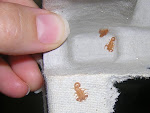 Eric York
Eric York
Plague is endemic to certain parts of the desert southwest. 10-15 people in the U.S. die of some form of plague each year, most of them in that region -- my region.
Primary pneumonic plague (PPP), in particular, is unsettling. While attending a 2-day public health conference this week, I learned all about the loveliness that this organism isn't. No flea vector is needed to transmit PPP (fleas vector the bubonic plague, the one that's well-known for widespread death in Europe during the middle ages). PPP jumps directly from one mammal to the next. It's high on the bio-terrorism list, with a near 100% mortality (w/in 6 days) if untreated, and transmission via aerosolized droplets from a sneeze, a cough, or... a necropsy
One of the conference talks by a U.S. Public Health Service medical doctor yesterday provided new details on a plague case that was widely publicized last fall. It was on the wildlife biologist, Eric York, working in the Grand Canyon National Park, who contracted the deadly Yersinia pestis bacterium (PPP) directly from an infected mountain lion. He was found dead in his home on Nov. 2, 2007, six days after performing a necropsy on the mountain lion, and just three days after calling in to work sick with flu-like symptoms. It made national headline news last fall, and with good reason... A potential outbreak of the most deadly form of plague, with the ease of direct human-to-human transmission similar to the common cold... Can you imagine that in a place as transient and populated as Grand Canyon National Park?
Only the biologist was infected with PPP, as it turns out, though 49 people who may have had some degree of interaction with York or the mountain lion (primarily park staff) were administered antibiotics. The CDC, epidemiologists and a slew of public health scientists were called in, among them was the guy who this week gave the presentation I attended. So I not only got to hear the science beyond what little the media covered, but I got to hear it straight from the horse's mouth.
The story of how York came to be contaminated with PPP is rare and scientifically fascinating, but also incredibly tragic. He had tracked the lion to a remote and off-trail section of the park using the signal from her radio collar. He came upon her dead, laying on her side, with fresh blood coming from her mouth. He captured the scene in a chilling photograph which was shown in the presentation. The blood was, in fact, the first of several subtle symptoms of pneumonic plague wreaking havoc on the lion’s respiratory system. His notes mention the blood and attribute it to potential trauma, which he suspects could have possibly been caused by a scuffle with another mountain lion since she had cubs in a den in that area.
York conducted the necropsy of the animal back at his garage, apparently without using any personal protective equipment. The photographs York took of this were shown, and are tough to forget. His hands -- his large, rugged, un-gloved hands covered in the blood that would later kill him -- held the skinned head of the female mountain lion in one photo. That photograph in particular captures her swollen lymph, another sign that the plague was at work within her. Other photos he took, which were shared, showed the lion's skinned body laid out in various positions, specifically capturing the coagulated blood pooled in the diaphragm area. His necropsy notes again suggest trauma; however, experts who've examined the photos believe it was PPP at work on the mountain lion’s lungs.
After York's death, health experts inspected the necropsy kit in his garage and found it to contain an unused mask and gloves, further demonstrating that York was not aware of the danger he was in while conducting the necropsy.
This is enough for today. I'll have to finish it in another post.

+reduced.jpg)


2 comments:
That is a chilling story, as a necropsy enthusiast, I now realize that plague is one more danger to be aware of.
Glad you got something out of the post, Max. After reading about Eric York, it amazes me, as I'm sure it does you, that more emphasis (or in some cases ANY emphasis) isn't put on precautions and personal protective equipment.
Post a Comment